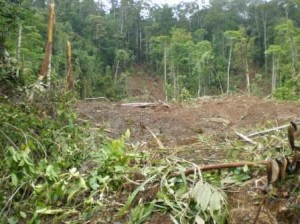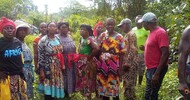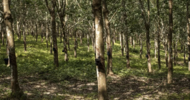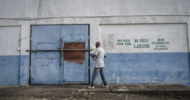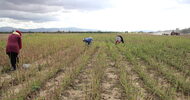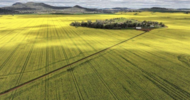Rosa Biwangko Moiwend, 2010
The Land of Papua, a land of great riches, a small paradise that fell to earth. This is how Frangky Sahilatua, the Malukan musician, sings the praises of the land of Papua in his song Aku Papua which is so popular thanks to the singer Edo Kondologit.
These riches have turned this small paradise into an attraction for investors from Indonesia and from around the world. Forests, land, water, minerals – everything is there to be plundered by these people. The lyrics are all too true: ‘All that land, all those rocks, the riches that are full of hope.’ Everything in that land is of priceless value. Not only the land itself but the savannahs that stretch for miles, the Kayu Putih (Melalaleuca sp), the peat and the tall, elegant trees in Merauke that cover 1,6 million hectares, full of hope that they will save Indonesia and the whole world from a looming food crisis. But then, what hope is there that anything will be left for the children and grandchildren of the owners of this land? Will all this be consumed by the people who come here just to collect those rocks that are full of hope?
In Merauke, in 2000, district chief Johanes Gluba Gebze offered Merauke as a granary when launching his massive project called the Merauke Integrated Rice Estate – MIRE. This was to be a fantastic programme, with the full support of the agriculture department of the central government. Then in 2008, when a food crisis struck the world, forcing up the price of food everywhere, many agrarian countries, including Indonesia, started to get busy, thinking up new sources of food round the world. This crisis provided the launching pad for increased investment in food production. This led to the Indonesian government and its department of agriculture looking everywhere for strategic locations, land that is unused, land with the potential to attract these investors.
In a presentation at the editorial office of Kompas in June this year, the IPB (Institut Pertanian Bogor) which had conducted research regarding the MIFEE project, said that Indonesia will face a crisis in 2010 – 2025. The lack of sufficient land in Java, due to the very rapid increase in population, has resulted because of the emergence of nine megalopolises in Java. This has resulted in a decline in the supply of food while the Indonesian population is estimated to increase to 300 million. This could lead to famine by 2025 which highlights the need to find a solution in the form of vast areas of land. Merauke was seen as the best way to solve the problem. Agus Sumule, an expert on the staff of the governor of Papua, said it would be an act of grave injustice because it meant that Papua, and especially Merauke, would be expected to bear all the consequences of the food crisis in the world and in Indonesia. This burden, he said, should be borne by districts throughout Indonesia, from east to west and from north to south. According to Sumule: ‘It is grossly unfair for a single province, a single district and still worse, a single ethnic group, to have to carry the burden of the national food crisis.’
Arguing in favour of the need to improve the local economy and in favour of food self-sufficiency, the Merauke project was enthusiastically welcomed by John Gluba Gebze. The local government and the central government then carried out their own studies and produced a draft for this project. The central government came up with the idea of a mega project called Merauke Integrated Food and Energy Estate (MIFEE), along with government regulation No 20/2008 on National Land Allocation, identifying Merauke as the main area for the national agricultural sector. These plans were drawn up unilaterally; there was no co-ordination between the central government and the provincial government. The district chief and his staff in Merauke sidestepped discussions with the provincial government. The result was that the Indonesian president enacted Inpres 5/2008 requiring the adoption of the MIFEE plan as part of provincial land allocation.
Taking several things into consideration, the provincial government recommended the allocation of 5,552 hectares for MIFEE, but the department of agriculture decided that 1.6 [million] hectares should be allocated to the project. An area of such huge dimensions, imposed on the map of Papua, includes not only agricultural land and transmigration sites which are suitable for food production but also virgin forests and protected areas including peat, water catchment areas and even residential areas including the kampungs of the indigenous people, the Malind people.
So, what about the people who live on this land? In all the discourse about the mega MIFEE project that has taken place between the Merauke district government and the central government, there has been virtually no mention of the indigenous people who live in the area. Yet, long before the Europeans ‘discovered’ New Guinea and the southern regions, the Malind-Anim (Malind people) had been living there for generations. Findings by anthropologists and missionaries like the Rev. E.B Savage from the London Missionary Society wrote about the Malind people in a publication of 1891. A.C. Haddon published the first portrait of the Marind/Malind people. And later Van Baal and several other Dutch anthropologists began to document the lives of the Malind/Marind people in the southern regions of Papua.
This project has been drafted without any mention of the human developments of the Malind people as one of its definitive impacts. Indeed, the central and local governments have given the impression that this land is uninhabited, that it belongs to no-one. The people who live in unity with nature and in their native dwellings have simply been ignored. During the planning stage, the indigenous people were never invited to negotiate, nor were they even told about the MIFEE project. They were kept quite unaware of the fact that their kampungs and villages would be included within the strategic mapping of MIFEE. As a result, their customary land has been valued at a very low price. Moreover, they face the threat of being relocated to land that belongs to other clans, when this project goes ahead.
The strategic planning of MIFEE does indeed say that the project will raise per capita income of the local people, that peasants will be supported by the provision of modern equipment and technology. But it also states that, in the initial stages, skilled transmigrants from outside Merauke will be moved in to run the project and to handle the transfer of technology. It will only be in the longer term that training centres will be set up to educate local people in the techniques of agricultural production. This raises the question: how will local peasants be involved in the project? It is extremely regrettable that such plans will only result in the further dis-empowerment of the Papua people in Merauke.
The marginalisation of the Malind people in Merauke can only get worse. Ever since the commencement of the large-scale transmigration programme and the inadequacies of education, health and economic facilities in Merauke, the Malind people have been elbowed out and have become nothing more than spectators. They have even become spectators in the transmigration kampungs. And what is even more regrettable, they will lose their customary lands as a result of the seizure of their land in the name of development, they will lose their customary systems and regulations. Their regulation of kampong boundaries, of village boundaries, their seasonal management as well as a range of customary laws will become indistinct and will disappear altogether.
With regard to the transfer of values and culture, our native language is more infrequently being spoken, the reason being that language is inseparable from land, water, forests, livestock, things that are all part of an inseparable unity. Should any of these elements be lost, the language gets lost too. Stories that pass down through the generations from our ancestors (Dema) become more and more difficult to understand because the sacred borders are replaced by rice-fields, fields of maize and palm oil plantations. The identity of the Malind people is gradually lost along with the destruction of the natural features that are the symbol of each clan. The Gebze with their coconut symbol, the Mahuze with their sago symbol, the Basiks with their pig symbol, the Samkki with their kangaroo symbol, the Kaize with their Kasuari and Balagaise (falcon birds) symbol; everything will get lost. In other words, the MIFEE food project will lead to the annihilation of the Malind people.
It is more than likely that in five or ten years time, the next generation of Malind people will no longer sing: ‘I grew up together with the wind, together with the leaves, together with the sago, together with the coconut trees.’ Instead, they will sing: ‘I grew up without the wind, without the leaves, without my sago village. I know nothing about my Dema, the symbol of my tradition, my language, my homeland. I will no longer be able to speak about my origins. All I will be able to say is that Papua is the land of my ancestors, the land where I was born.’
Because of all this, no-one should be surprised when people start describing MIFEE as a clear case of genocide by the Indonesian government, because it has been well-planned and well-organised. All the legal elements are there: government regulations, presidential instructions, the strategic planning and the maps that provided the necessary requirements for genocide.
When all these cries are heard, the Indonesian government will have to be ready to take the consequences, it will have to take responsibility before the ancestors of the Malind people, the Papuan people and the international community.

